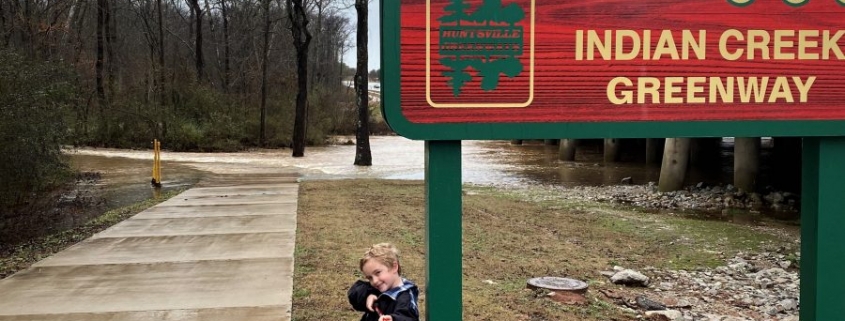Local Greenways — The Blessing of Urban Floodplains!
I’ve enjoyed many hours biking and walking along our local Madison, Alabama greenways: Bradford Creek; Mill Creek; and Indian Creek. Note the commonality — each bears a creek moniker. One might assume city planners wanted us to experience the peaceful streamside environment, the gurgle of flowing water, and the shade of the riparian forests. Not a bad assumption. However, other reasons prevailed. Here in northern Alabama’s Tennessee Valley, Nature blesses us with an annual average of 55 inches of rainfall. Our streams overflow their banks several times each year. So, their floodplains are not suitable for residential or commercial development. Five-and-a-half-year-old grandson Sam and I visited Indian Creek and Bradford Creek greenways January 3, 2020. I had measured eight inches of rain over the prior 13 days. That’s roughly 15 percent of our annual precipitation! Light rain continued as we walked. The heaviest rains had fallen the prior evening; the streams had begun to fall.
Indian Creek Greenway
I asked Sam to stand by the Indian Creek Greenway sign. Ever-ready with appropriate armament, he decided to aim back with his trekking pole. Beyond him the trail dips into Indian Creek, flooded impassably.
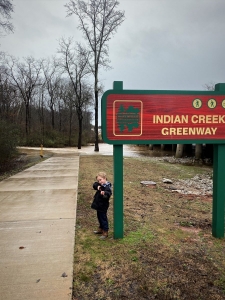
Seen from the highway bridge above the trail and at water’s edge, the creek gives little deference to the paved greenway. As always, Nature holds sway. We are wise to know and respect her ways. What better application of land use than to dedicate a riparian zone to recreation.
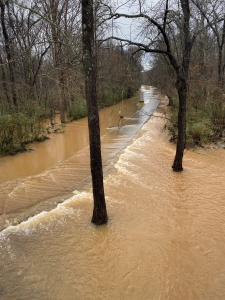
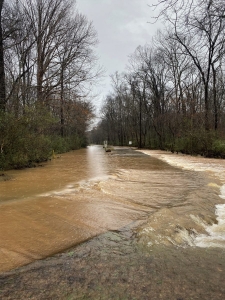
But there is more. Bradford Creek and Indian Creek greenways serve another purpose. Both are rights-of-ways for public sewer lines, a conscience and deliberate effort to place utilities where they do not interfere with commercial and residential development. I accept and applaud the complementary uses of utility right-of-way and recreational corridor. As I pedal I pay no heed to the surface manifestation of the underground utility (photo below from a week later (January 12) along the Bradford Creek trail), the flood waters long since subsided.
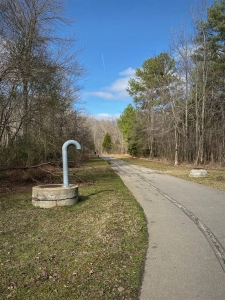
Where the water rose above the trail surface, a crayfish scurried across the pavement. Sam and I picked him up, avoided his pincers, said hello, and placed him back into his watery realm.
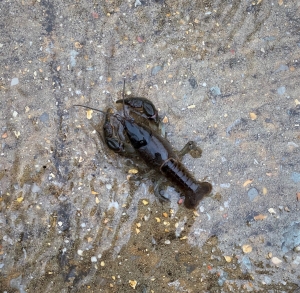
Bradford Creek Greenway
Because Indian Creek was so completely underwater Sam and I drove the three miles or so west to Bradford Creek. Indian Creek was two or three hours past peak flood flow. Bradford Creek is a lower order stream, having reached maximum flow around midnight. Stream order describes the hierarchical sequence of streams within a watershed. Small headwater streams are first order. Their flow peaks while the deluge is falling. Bradford Creek is probably second order, formed from several first order streams draining Madison City neighborhoods. Sam is sitting on and standing by a log that washed over the culvert during the night. The creek has already fallen a couple feet below peak flow. Indian Creek, a higher order stream, was still close to peak.
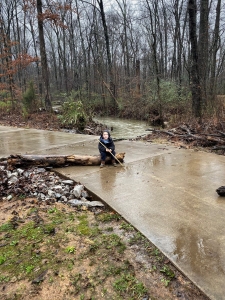
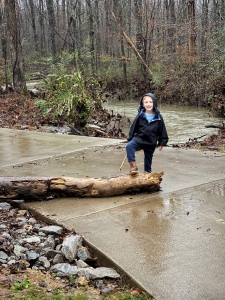
Stream order classification rises to a high of 12. The lower Mississippi rates a 12. The peak flow at New Orleans may lag several weeks behind the spring dousings and snowmelt that inundated farmlands of the upper Midwest. I wonder, how many Bradford Creek watershed equivalents would it take to furnish the Big River’s flood-flow at its Gulf outlet. And then compare that to the world’s largest volume river, the Amazon. The Amazon carries more volume than the next eight largest rivers in the world combined. It has ten tributaries larger in volume than our Big River. If we could redirect the Amazon’s outlet flood-flow into an empty Lake Ontario basin, the lake would fill in three minutes. As I marvel at the force of Bradford and Indian creeks in flood, I once again feel overwhelming humility knowing that this is nothing to the Amazon and our own Mississippi. All things natural are relative.
The Special Magic of Wet Tree Trunks
Forest hydrology stood among my top five favorite undergraduate courses. According to the US Forest Service, Forest hydrology studies the distribution, storage, movement, and quality of water and the hydrological processes in forest-dominated ecosystems. Forest hydrological science is regarded as the foundation of modern integrated watershed management. Our spring-break field trip that semester took us to Hubbard Brook Watershed, a world famous calibrated, monitored US Forest Service hydrological research station deep in New Hampshire’s White Mountains. I felt as though I were heaven-bound as I drove the university van north and east through the Adirondacks toward northern New Hampshire. Spring break at a Florida beach — not for me! I would have traded the Hubbard Brook trip for nothing… neither fame, nor fortune, nor warm ocean breezes.
The forest hydrological system begins in the tree canopy, where raindrops (and snowfall) first meet the forest. Let’s stick with rain. The fate of rain in the canopy: evaporation from twigs and leaves; throughfall to the forest floor; stemflow. Tree crown geometry for many species funnels canopy water along twigs, stems, and branches toward the trunk. A little over three-inches of rain fell during the 36 hours prior to Sam and me hitting the two greenways. This American Beech (Fagus grandifolia), a species with widely-spreading dendritic branching pattern, is particularly skilled in drawing water to its trunk. This one is soaked, every nook and cranny thoroughly wetted. Its bark supports rich communities of algae and lichens, much of it far less visible on dry bark. Sam and I marveled over the beech bark palette of life.
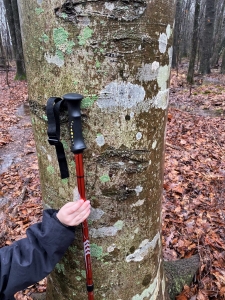
We also saw magic in the beech fingers clinging tightly to the riparian forest floor. Don’t we all cling fiercely…and lovingly…to those things, places, and people we hold dear. Security comes in many forms. I know from my training as an ecologist and soil scientist that all terrestrial life on Earth begins and ends with that fragile layer we call soil. This beech symbolizes our universal dependence on this thin layer of weathering rock, organic matter, rich microbiological life, water, and gas (oxygen, carbon dioxide). Sadly, the vast majority of humanity is excruciatingly oblivious to our need to cherish, tend, and protect our One Earth and its life-sustaining soil. Let this beech teach us to be informed and responsible Earth stewards.
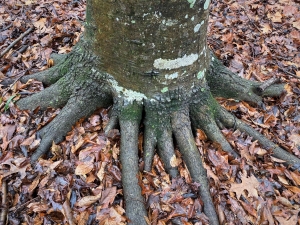
A Footnote
I offer another tribute and appreciation to our Land Trust of North Alabama for its partnership in creating the Bradford Creek Greenway and other special places locally. I love the Land Trust’s tagline: Conservation in Action! As a former four-time university president, I hold that application adds value to knowledge. Applying knowledge (driven by dedication and passion) brings action to bear. Without applying action to conservation, we as humanity, communities, and individuals practice only a shallow and meaningless conservation inaction. Amazing how removing that one space (between ‘in’ and ‘action’) changes the entire essence. Talking by itself can amount merely to conservation virtue-signaling. The Land Trust gets it done! I applaud its action, guided by a succinct and noble mission: The Land Trust preserves land and its legacies for conservation, public recreation, and environmental education to enhance quality of life in North Alabama now and for the future.
The Land Trust donated a 112-acre easement to the City of Madison (2006) for the Bradford Creek Greenway. The aerial photo shows the property lines (green) and the 2.5-mile trail (red) from Heritage School to Palmer Park. I have spent many hours biking along the creek under its welcome riparian forest cover and shade. A wonderful gift to future generations.
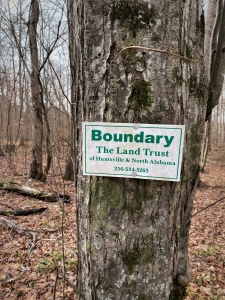
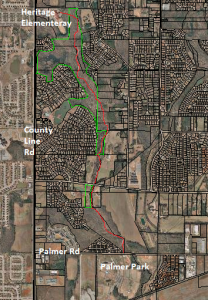
Thoughts and Reflections
I wrote my books Nature Based Leadership (2016), Nature-Inspired Learning and Leading (2017), and Weaned Seals and Snowy Summits: Stories of Passion for Place and Everyday Nature (2019; with co-author Dr. Jennifer Wilhoit) to encourage all citizens to recognize and appreciate that every lesson for living, learning, serving, and leading is either written indelibly in or is powerfully inspired by Nature. All three are available on Amazon and other online sources.
Here are three succinct lessons I draw from this Blog Post:
- Nothing in Nature is static… from peaceful stream to raging torrent
- An urban riparian zone presents both a land use restriction and a wonderful recreational opportunity
- Land Trust organizations can be essential partners in conserving Nature close to home
Inhale and absorb Nature’s elixir. May Nature Inspire and Reward you!
Note: All blog post images created & photographed by Stephen B. Jones unless otherwise noted. Please circulate images with photo credit: “©2020 Steve Jones, Great Blue Heron LLC. All Rights Reserved.”
Another Note: If you came to this post via a Facebook posting or by an another route, please sign up now (no cost… no obligation) to receive my Blog Post email alerts: https://stevejonesgbh.com/contact/
And a Third: I am available for Nature-Inspired Speaking, Writing, and Consulting — contact me at steve.jones.0524@gmail.com
Reminder of my Personal and Professional Purpose, Passion, and Cause
If only more of us viewed our precious environment through the filters I employ. If only my mission and vision could be multiplied untold orders of magnitude:
Mission: Employ writing and speaking to educate, inspire, and enable readers and listeners to understand, appreciate, and enjoy Nature… and accept and practice Earth Stewardship.
Vision:
- People of all ages will pay greater attention to and engage more regularly with Nature… and will accept and practice informed and responsible Earth Stewardship.
- They will see their relationship to our natural world with new eyes… and will understand more clearly their Earth home.
Tagline/Motto: Steve (Great Blue Heron) encourages and seeks a better tomorrow through Nature-Inspired Living!
Steve’s Three Books
I began writing books and Posts for several reasons:
- I love hiking and exploring in Nature
- I see images I want to (and do) capture with my trusty iPhone camera
- I enjoy explaining those images — an educator at heart
- I don’t play golf!
- I actually do love writing — it’s the hobby I never needed when my career consumed me
- Judy suggested my writing is in large measure my legacy to our two kids, our five grand kids, and all the unborn generations beyond
- And finally, perhaps my books and Blogs could reach beyond family and touch a few others lives… sow some seeds for the future
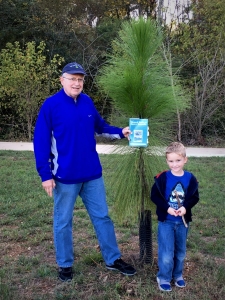
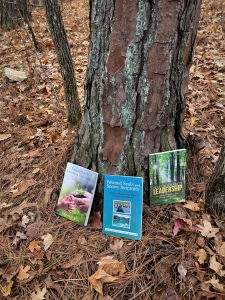
All three of my books (Nature Based Leadership; Nature-Inspired Learning and Leading; Weaned Seals and Snowy Summits) present compilations of personal experiences expressing my (and co-author Dr. Wilhoit for Weaned Seals and Snowy Summits) deep passion for Nature. The books offer observations and reflections on my relationship to the natural world… and the broader implications for society. Order any and all from your local indie bookstore, or find them on IndieBound or other online sources such as Amazon and LifeRich.

